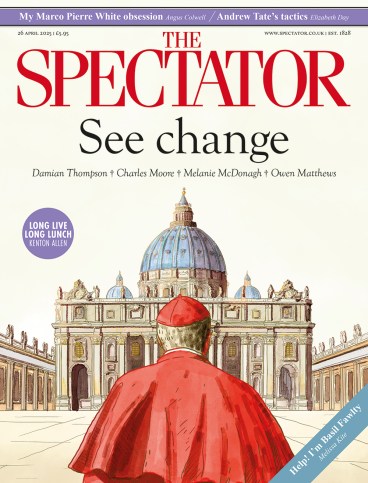
Owen Matthews has narrated this article for you to listen to.
Ordinary Romans, famous for their cheerful working-class familiarity, loved Pope Francis for his common touch. For the first time in living memory, they will have the opportunity of turning out on the streets to say their final farewells to a Pope, as Francis willed that he be buried in the papal basilica of Santa Maria Maggiore on the Esquiline hill rather than in the vaults of St Peter’s. His will be the first papal burial procession to the Basilica since Clement IX’s in 1669. Unlike his predecessors, though, Francis insisted on plainness, economy and simplicity. His first arrival in the Vatican as Pope was by public bus. His departure, in a plain wooden coffin, is likely to be equally low-key and dignified.
The mortal Pope dies, but the Eternal City lives. And, indeed, is reborn. Like a Parioli matron shedding her curlers, pins and hairnet in anticipation of a major family celebration, Rome’s monuments are emerging from shrouds of cladding and scaffolding ready for their close-up. The angels and river gods of the Ponte Sant’Angelo and the Piazza Navona shine as blinding white as the day they emerged from Bernini’s workshop. The ancient granite basins of the Piazza Farnese fountains shimmer with an ethereal bluish light.
The big occasion is the Papal Jubilee year of 2025, a four-times-a-century celebration expected to draw a whopping 32 million visitors. That’s more than ten times Rome’s population. Holy Doors have been opened in the four papal basilicas, plus an extra one in Rome’s Rebibbia prison, and any pilgrim who passes through these portals will earn a plenary indulgence with ‘the remission and forgiveness of sins’ including ‘suffrage to the souls in Purgatory’, according to the Jubilee Penitentiary Guide. At the first jubilee of 1300, pilgrims had to go through every Holy Door every day for 15 consecutive days. This time just the once will suffice, with bookings available via a special app.
Hostile observers – such as Martin Luther, who spent some time in Rome in 1510 during his career as an Augustinian monk – have claimed jubilees were invented as a papal money-making exercise designed to boost the pilgrim trade. ‘The Church of Rome has become the most lawless den of thieves, the most shameless of all brothels, the very kingdom of sin, death and hell,’ wrote Luther, who seems not to have enjoyed his stay in the city he referred to as the Synagogue of Satan. ‘Not even Antichrist, if he were to come, could devise any addition to its wickedness.’ Though much has changed since Luther’s day, Rome’s entrepreneurial holy spirit still runs strong. Special pilgrim centres sell a wide selection of jubilee merch, including fetching green pilgrims’ capes. And the hit show of the year, advertised on billboards all over the city, is Jesus Christ Superstar.
Rome is a company town and the Catholic Church is Italy’s most globally influential institution. Small wonder, then, that the Italian state has opened its purse strings to produce €4.8 billion and counting to restore, rebuild and generally scrub up the city in a programme dubbed ‘Roma: Caput Mundi’, or Capital of the World. Four major squares have been remodelled, along with 30 underground stations. A whole new metro line is under construction, along with 600 other major urban improvement projects. ‘It’s a miracle,’ says Rome’s mayor, Roberto Gualtieri. But for many Romans the true miracle is the appearance of hundreds of stylish column-shaped rubbish bins which are emptied daily. At a fiscal controller’s keystroke, Rome’s litter problem has been banished like a bad dream.
Not all Romans are happy with these improvement programmes. One prince complains bitterly that a new cycle lane has banished a whole street’s worth of private parking. His is one of the three private family homes in town that boast both a papal throne and a Caravaggio, and he can park in his own courtyard. But how will his guests and staff manage?
Friends in low places are also discontented. Our local tramp Fede, the very smelly and opinionated inhabitant of the Piazza dell’Oro, is annoyed at the great programme of relaying all of Rome’s cobblestones. These hand-napped black stones, known as sanpietrini (a wordplay on pietro, meaning both Peter and stone), were mostly laid during the reign of Pope Pius V (1566-72). Which means that one is walking literally on the same stones as Caravaggio, Goethe and Garibaldi. The sanpietrini are not being replaced but merely relaid on new sand and gravel beds to erase their current ankle-breaking dips and divots. This is done painstakingly by hand. Fede’s objection is not so much to the process as to the personnel making their way down Via Giulia, who are from Puglia. These hardworking fellows, like all Italian workmen, conduct shouted conversations in guttural and incomprehensible dialect, all day without pause. Fede considers them porci stranieri – foreign pigs.
Our neighbours, Trevor and his wife Rita, are unable to express an opinion because they are coypu, large rodents known in Rome as castorini or ‘little beavers’. They live on a small island under the Ponte Amedeo di Savoia, and over the past six months have seen much of their habitat ripped up in the name of beautification and progress. This is a great pity, as the unkempt banks of the Tiber until recently formed a spontaneous nature reserve running through the heart of the city. But despite the depredations of the jubilee, I was happy to see Trevor – a heavily moustachioed fellow, 2ft long from nose to tail – splashing about, oblivious to the disruption. Like the late Pope Francis, Trevor and his family are from South America, brought to Italy by furriers a century ago. Happily for both of us – and true to his late Holiness’s central message of charity – the Eternal City seems content to welcome, or at the least tolerate, all comers.
Catholic theologian Fr Alexander Lucie-Smith joins Damian Thompson on the latest Holy Smoke podcast to discuss what Pope Francis’s legacy might be:









Comments